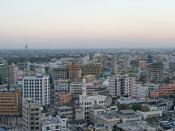Population:Tanzania is no small country (compared to some) at around 40 million people (39,384,223 by July 2007), at a total fertility rate of 4.77 children born/woman). Due to various reasons, one major being AIDS, their life expectancy at birth is a discouraging 50.71 years.
Health Problems:-HIV/Aids: 1.6 million people in Tanzania with HIV/AIDS-Other major health issues are malaria, sleeping sickness and tuberculosis-Doctors per capita 0.02/1000 (i.e. 1/50,000)-Under 5 mortality rate 165/1000 childrenEconomy:Tanzania is one of the 10 poorest countries in the world, with the GDP per capita being a poor $800. 36% of the population is under the poverty line and 19.9% live on less than $US1 per day. Almost 50% of GDP comes from agriculture, which accounts for almost half of GDP, provides 85% of exports, and employs 80% of the work force. The majority of Tanzanians are subsistence farmers. The small, wealthy groups of the country are mainly Asian and Arab business families.
Tertiary, Primary, secondary industries:Most of the world production of cloves comes from Zanzibar and Pemba islands. Coffee, cotton, sisal, cloves, tea, tobacco, and cashew nuts are the main export crops, and peppers are also exported. TanzaniaÃÂs principal food crops include cassava, maize, sugar cane, rice, sorghum, millet, wheat, sweet potatoes, and plantains. The livestock population in 2004 included about 17.8 million cattle, 12.5 million goats, 3.52 million sheep, and 31.3 million poultry. More than 15,500 tones of honey are produced each year.
Tanzania is classified as a less developed country due to its poor effort in sustaining its income gained from natural resources. A classic example of this is issue of the Nile Perch of Lake Victoria, being exported to European countries for a much lower price than it is sold over there. The annual fish catch in 2001 was about 336,200 tones, more than...


